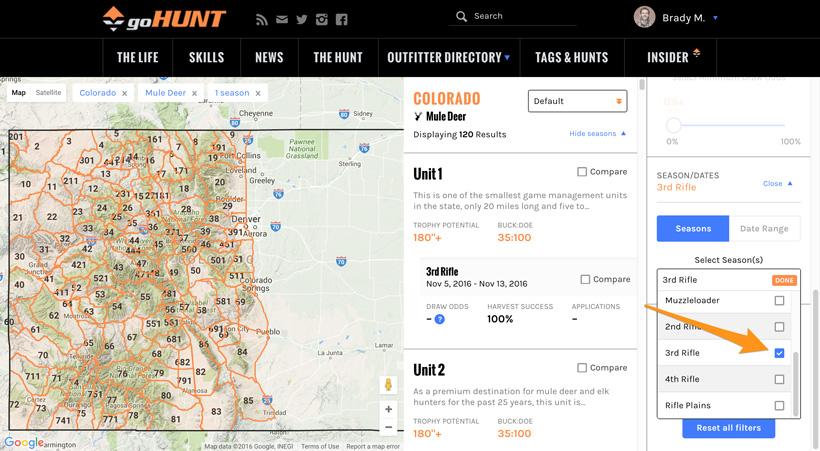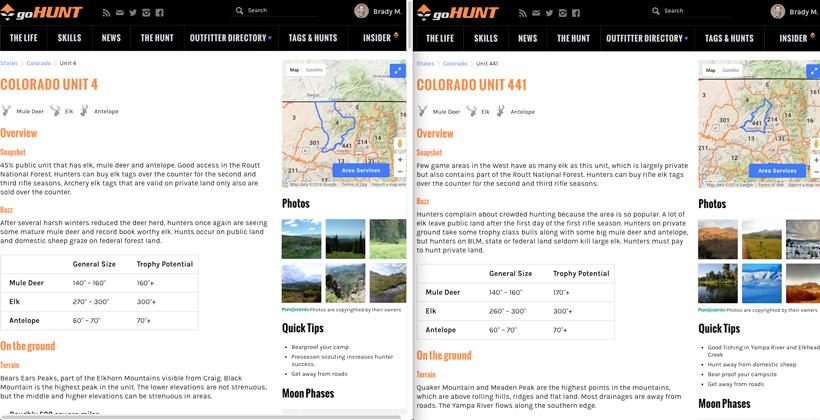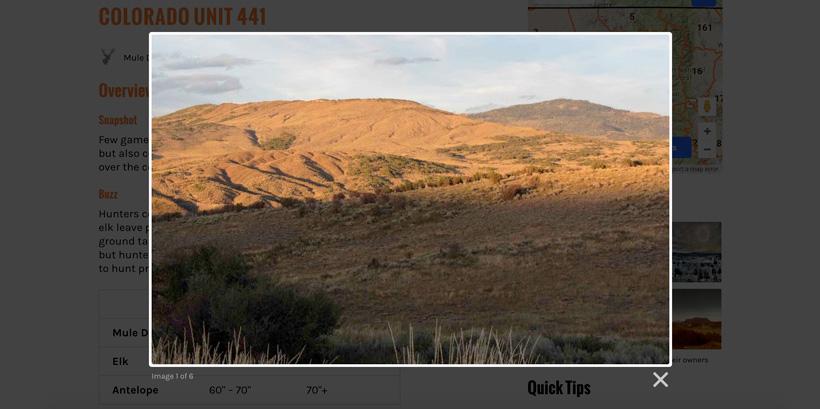






Comparing two units on a widescreen monitor is a great way to figure out what unit is better for your style of hunting.



I've always said that INSIDER is worth it's weight in giant mule deer! But all that research you went through on INSIDER to find a place to apply and then draw a tag, isn't all that you can do.
Once you draw a tag… there are a few dilemmas we all deal with; like how to narrow down where to hunt. This can be a bigger deal for some of you that might have a tag that is valid in multiple units and you need a way to narrow down one unit that is worth your hunting time. An example of this situation would be some unit groups in Colorado, general tag regions for nonresidents in Wyoming and even over-the-counter (OTC) units.
Let’s say you drew a 3rd season rifle for Unit 4 in Colorado which allows you to hunt in Units 4, 14, 214, and 441. If you’re an out of state hunter, you can’t waste your time trying to scout each unit or just take a guess and pick the unit that “looks” best on a map. You need to narrow it down to one unit so you can start to put pins on a map.
For units that are along state borders, I highly recommend to also research units on the other side of the state border. This information is helpful if that unit across the border is a trophy unit that might take 10 plus years to draw, or if fall snowstorms causes deer to migrate across the state line to or from your unit.
For this example, Unit 4 borders Wyoming's Region W and more specifically Area 82 - Baggs. If you open up that Area Profile you will see that the last Wyoming rifle season in that area closes October 10. So if deer experience heavy hunting pressure in the northern portion of Unit 4, they will likely cross the Wyoming border to avoid hunters. From that bit of information it might not be worth a hunter's time to look for third season deer in the northern half of Unit 4. Area 82 in Wyoming is also a relatively easy tag to draw for a nonresident with a trophy potential of 170"+ so that information also doesn't lead to me wanting to hunt north in Unit 4.
Finding OTC units to hunt should be devoted to an entire article, but I will quickly give you an example. To get started, I will use Filtering and search for Idaho mule deer.
Overall, the amount of research you can do on INSIDER is endless. It is a huge time saver when researching for areas to apply, researching for tags you have already drawn or to find new OTC opportunities. In the end it all comes down to what type of hunt you're looking for. All of this research is a small, yet important part of your overall strategy for figuring out where you want to hunt. That is the real power of INSIDER. You can make the product work for your own personal goals to find great hunting opportunities all across the West — all you need are the right set of tools to find them.
Navigate to Filtering and select Colorado then click on Mule Deer. You will see a list of 185 units.
Since you drew a Unit 4 3rd season rifle tag, on the Filtering 2.0 dropdown box, scroll down to Select Season(s) and select 3rd Rifle. Now on the left, you can click on the boxes next to Compare for all of the units that your tag is valid in. Select Unit 4, 14, 214 and 441. Note: you can click on the Hide Seasons button at the top to make it easier to compare units.
Once you’ve selected your units, you will notice an orange compare box appear at the bottom of the screen. It will show that you have "4 Units, and 4 Seasons" selected. Click Compare. The map and results will now adjust and only show you the units you selected.
At this point it is handy to zoom in on the unit boundary map.
At the top of your results, click Show seasons to expand the season information to see harvest success (tag allocations and draw odds would show up if you selected your residency under Draw Odds, but since you already have the tag, we don’t need to show that information).
You'll notice that Unit 14 and Unit 441 stand out with 170” trophy potential. Buck to doe ratios are all 39:100 for the four units. So we must now move to other information to fine tune our unit to hunt.
It’s a great idea to compare the harvest success for those units. I feel like this is very important information to use when you narrow down your hunting location. Yes, harvest success can vary from year to year, or you might think that you can do better than other people in terms of tagging out, but harvest success is a very good indicator at how good a particular unit may or may not be. You will see that the two units with 170"+ trophy potential have drastically different harvest success rates. Unit 14 has a downward harvest success trend of 13% and Unit 441 has a drastically higher harvest success at 83% that is trending upwards. Another notable unit is Unit 4 at 83%, but this unit only had a 160"+ trophy potential. I still wouldn't throw this unit out of the list of places to hunt. You will see why below when we confirm what unit to hunt based on the information in the Unit Profiles.
So, does the significantly higher harvest success in Unit 441 make this a clear choice over Unit 14? I'd say so! The reason I'd say that you should hunt Unit 441 over Unit 14 for a 3rd season tag is due to migrations. Unit 14 is right next to Steamboat Springs and a bunch of very remote mountains. You have a third season tag, so bucks in this unit are going to be looking to get out of the high country by early November. You won't find many bucks above 10,000 feet in November, unless there is unseasonably warm weather. The Unit 14 profile also confirms this in the Buzz section, "This unit is best for archery elk, early deer rifle and muzzleloader seasons." Once again this showcases the power of the Unit Profiles.
What about Unit 4 with the high harvest success? Let’s take a closer look at Unit 4 and Unit 441 and use the Unit Profile information to see where we could hunt.
An alarming thing to consider is the first sentence of the Buzz section on the Unit 441 profile, "Hunters complain about crowded hunting because the area is so popular." If I only have five days to hunt mule deer, this alone might cause me to sway toward Unit 4. Even if those are 3rd season elk hunters, I wouldn't want to hunt mule deer will all those elk hunters running around the mountains.
Right away you will see in the On the ground section that Unit 441 has some private land issues. Not only does it have more private land, but a lot of the animals move to the private after the first rifle season, that information is again confirmed in the profile. Unit 4 is 55% private compared to Unit 441 at 68%.
You will also notice that the terrain in very similar in both units. If the terrain was vastly different, you could use that to your advantage to narrow down your option like I did earlier by eliminating Unit 14. If you like a big mountain hunt because you want to possibly get away from the crowds, you could go with Unit 4 and if you like more rolling terrain, where you have to deal with locating bucks moving to and from private land, then go with Unit 441. Another way to research the unit is to quickly browse the unit boundary map we provide. Expand the map and check out the terrain in satellite view or map view.
Another part of the Unit Profile that can be valuable to compare is historical temperatures. You will see that Unit 4 and Unit 441 vary by only a few degrees. So in this case the historical temperature won't help you narrow down a unit that might have a better early rut, but it will tell you that you can expect average temperatures hovering right around freezing for your entire hunt. One thing to note, if you scroll down further in the profile, a lot of times harvest success and temperature are related. What I mean by that, when harvest success is lower for a 3rd season hunt, the average November temperature is also lower. That is just something to keep in mind. I also place a lot of value in the Historical Precipitation section. This is great for seeing what unit might have had more snowfall. For me snowfall means colder temperatures which will increase the chances that a buck will be on his feet for longer duration of time and it means that I can have a better chance to spot a buck against a white blanket of snow.
In the Species within this Unit section under mule deer, you will see some very important information that may help you with your decision. Unit 441 has this description, “Most big bucks are on private land or show up during the rut, which sometimes starts during the third season. Hunting pressure moves bucks off the national forest onto private land.” For me, that would seal the deal and I would be headed to Unit 4 to chase bucks in Colorado.
Select Filtering 2.0
Select Idaho.
Select mule deer. You now have 99 units selected.
Adjust the Trophy Slider to your desired size. I will chose 180"+.
Adjusting the slider to 180"+ now narrowed down the units to 16 results.
Scroll past draw odds because we are looking for an OTC hunt.
Select which season(s) you are wishing to hunt. Have other hunts going on throughout the fall? You can also set your date parameters and Filtering 2.0 will automatically find what's in season that time of the year.
For this example I am using Archery (Over the Counter).
You have now narrowed the units down from 99 to 10.
Lastly, click on any of the remaining units to read in-depth profiles containing valuable information.
Researching 10 units is much easier than starting with 99.
Next, you can sort by M:F Ratio
Now it shows Unit 67 is the best choice based on the criteria I selected. This unit has 180"+ trophy potential, 35:100 buck to doe ratio and 71% of the bucks taken are four point or better. Sounds impressive!
The next step would be similar to my strategy I used above in the Colorado example where I would take two or three of the top units and dive into their Unit Profiles to find out which unit I will hunt.